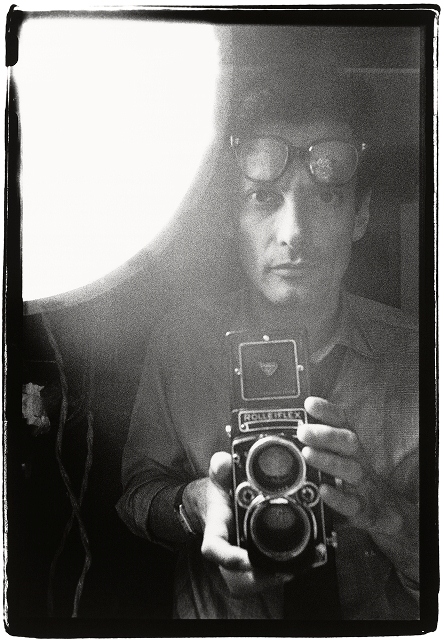Richard Avedon

Image © The Richard Avedon Foundation
Born: New York, U.S., 1923
Died: San Antonio, U.S., 2004
Richard Avedon (1923–2004) was born to parents of Russian Jewish heritage in New York City. As a boy, he learned photography, joining the YMHA Camera Club at the age of twelve; later, he took up poetry, winning a citywide award for high school students during his senior year at DeWitt Clinton in the Bronx. Avedon joined the armed forces in 1942 during World War II, serving as Photographer’s Mate Second Class in the Merchant Marine.
Making identification portraits of the crewmen with his Rolleiflex twin lens camera—a gift from his father—Avedon advanced his technical knowledge of the medium and began to develop a dynamic style. After two years of service he left the Merchant Marine to work as a photographer, making fashion images and studying with art director Alexey Brodovitch at the Design Laboratory of the New School for Social Research. In 1945, Avedon set up his own studio and worked as a freelance photographer for various magazines. He quickly became the preeminent photographer used byHarper’s Bazaar. There, under the tutelage of Brodovitch, his rise to the top of the profession was meteoric. Avedon developed an original approach to making fashion photographs. He showed the models full of expression: smiling, laughing, and often posed in action. Inspired by Hungarian photojournalist and fashion photographer Martin Munkácsi, Avedon photographed models and fashions on the streets, in nightclubs and circus arenas, and in other locations then uncommon.
From the beginning, Avedon made portraits for editorial publication as well: in the pages of Harper’s Bazaar, in Theater Arts, and in Life and Look magazines. From the outset, he was fascinated by photography’s capacity for suggesting the personality and evoking the life of his subjects. Only rarely did he idealize people; instead, he presented the face as a kind of landscape, with total clarity. He registered poses, attitudes, hairstyles, clothing and accessories as vital, even revelatory elements of the personal image. “My photographs don’t go below the surface. I have great faith in surfaces. A good one is full of clues.” Avedon continued to make portraiture and fashion photography for magazine publications throughout his career. After parting ways with Harper’s Bazaar in 1965, he began a long-term relationship with Vogue that continued through 1988. In later years, he established formidable creative partnerships with the French publication Egoiste, and with The New Yorker. In the pages of these periodicals, Avedon reinvigorated his formalist style, investing his imagery with dynamism and theatricality. In addition, he supported his studio by making innovative advertising work for print and broadcast – defining the look of brands like Calvin Klein, Versace, and Revlon.
As his reputation grew and his signature aesthetic evolved, Avedon remained dedicated to extended portraiture projects as a means for exploring cultural, political, and personal concerns. In 1963-64, Avedon examined the civil rights movement in the American South. During the Vietnam War, he photographed students, countercultural artists and activists, and victims of the war, both in the United States and in Vietnam. In 1976, on a commission for Rolling Stone magazine, he produced The Family, a composite portrait of the American power elite at the time of the country’s Bicentennial election. Some of Avedon’s most extraordinary portraits were taken of his father Jacob Israel Avedon during the last years of his life: a photographic confrontation with, and ultimate acceptance of, his illness and subsequent death.
In 1985, Avedon created his magnum opus – In the American West. He portrayed members of the working class: butchers, coal miners, convicts, and waitresses, all photographed with precisionist detail, using the large format camera and plain white backdrop characteristic of his mature style. Despite their apparent minimalism and objectivism, however, Avedon emphasized that these portraits were not to be regarded as simple records of people; rather, he said, “the moment an emotion or a fact is transformed into a photograph it is no longer a fact but an opinion.”
Avedon produced and published a number of books over the years. In addition to In the American West(1985), his books include Observations (1959), Nothing Personal (1964), Portraits (1976), and his fashion survey Photographs 1947–1977 (1978). His first museum retrospective came in 1962, at the Smithsonian Institute, and his photographs have been widely exhibited in museums since then: Avedon at the Minneapolis Institute of Arts (1970); In the American West at the Amon Carter Museum (1985); Richard Avedon: Evidence 1944-1994 at the Whitney Museum of American Art (1994); and his final retrospective,Portraits, at the Metropolitan Museum of Art (2002). Since his death, his work has been included in a number of survey exhibitions, most recently, Avedon Fashion 1944-2000 at the International Center of Photography (2009). A complete chronology can be found at www.avedonfoundation.org Twitter- @Avedon.
Richard Avedon Biography

